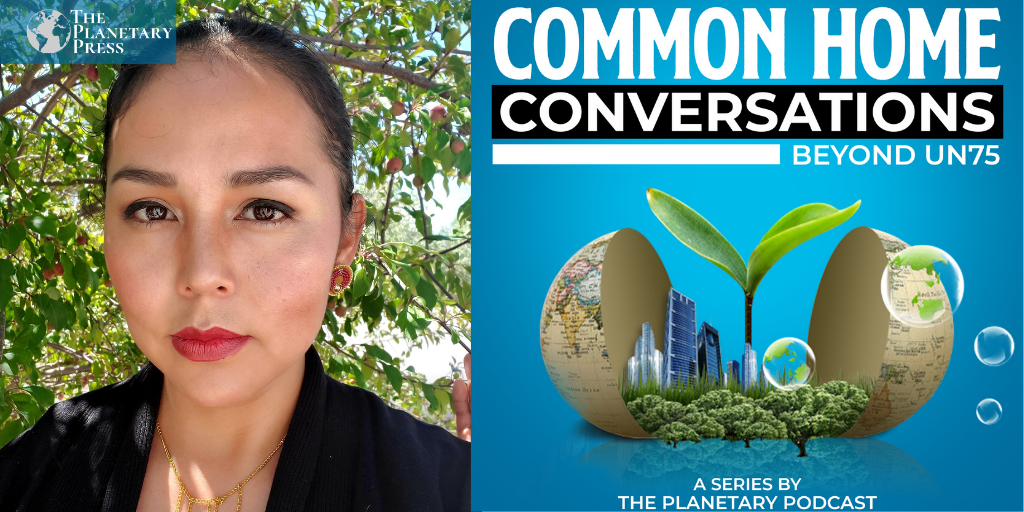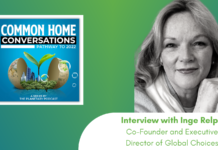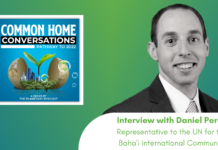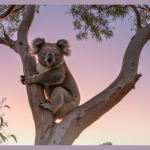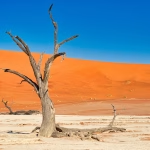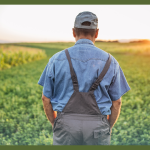Interview Transcript
Transcribed by Otter AI
Kimberly White
Hello and welcome to Common Home Conversations. Today we are joined by Janene Yazzie, Co-Convenor of the Indigenous Peoples Major Group on Sustainable Development. Thank you for joining us, Janene. Please tell us more about your work as Co-Convenor of the Indigenous Peoples Major Group on Sustainable Development of the UN High-Level Political Forum on the 2030 Sustainable Development Goals?
Janene Yazzie
Yes, the International Indian Treaty Council and Tebtebba Foundation really organized themselves to get involved with the beginning of the discussions around the Sustainable Development Goals. And our colleagues Galena and Roberto Borrero were really at the forefront of ensuring in the negotiations around the development of the SDGs that Indigenous peoples were included. And because of that work and the recognition of the shift from the Millennium Development Goals to the Sustainable Development Goals was a shift meant to increase participation of stakeholders and other civil society organizations. It became very apparent for our organizations and our two colleagues that we had to be participating in the development of the metrics and the development of the processes for meeting the Sustainable Development Goals. And so because of them, Indigenous peoples are mentioned throughout different aspects of the goals and the metrics that were created to measure progress towards implementation. The Tebtebba Foundation and International Indian Treaty Council became recognized as the co-conveners of the Indigenous Peoples Major Groups. We’re one of nine civil society organizations and major groups that are recognized and that engaged with the high level political forum on the SDGs. And through that work, we ensure the participation of Indigenous representatives from all of the seven social-cultural regions recognized by the UN. And we facilitate their participation in expert group meetings in high-level discussions during the HLPF as well as all of the other side events that happened with other mechanisms. And in this manner, we ensure that the countries that do submit voluntary national reports. Countries that are developing processes and mechanisms nationally to address the goals outlined in the 2030 agenda are also being held accountable to the Indigenous peoples that reside within their territories. And it’s been a lot of slow work for a while.
I think it’s taken a while for this mechanism to find its footing and for the high level political forum to really be structured and organized in a way to make it meaningful. And it’s been an uphill battle to increase and advocate for meaningful participation in the actual decision making processes of the high level political forum. But just in the past three years that I’ve been involved in learning about the history and the development of the Indigenous Peoples Major Group and our involvement with the SDGs, we’re seeing a great shift of the streams of work, of the way that the SDGs are being picked up more and more by different countries, and even how the work all of the streams of work are being collaborated across the different UN mechanisms. So it’s an exciting time. Obviously, with COVID-19, it made our issues much more difficult to get addressed. One of the things we’ve learned as being co-convenors of the Indigenous Peoples Major Group is that so many of our Indigenous peoples and the communities they come from lack access to critical community infrastructure, especially internet and cell service. And so with the COVID-19 pandemic, we faced some extraordinary barriers and challenges to keeping momentum behind increasing meaningful participation in the high level political forum and in the expert group meetings on the different Sustainable Development Goals.
So we’ve been working very hard to get resources, financial or otherwise, to some of our most vulnerable communities. To somehow support them getting hooked up to the internet, or to service that can allow them to continue the work that we’ve been doing collectively across our different regions. And it’s through that collaboration that we really find our strength as Indigenous peoples, you know, like all of our communities are on the frontlines of the impacts of climate change, of environmental degradation, of unsustainable development, and development schemes that are harmful to our ecosystem functions and to the continuance of our traditional lifeways. And so by serving as co-convener, we really serve as like the facilitators of organizing our movement and advocating collectively for our rights in these spaces.
Kimberly White
Well, you’re doing such important work- it’s fantastic. And like you said, Indigenous peoples are on the frontlines of climate change. We’re seeing it impact all corners of our planet. Can you tell us how climate change is affecting the Navajo Nation and what you see in your community?
Janene Yazzie
Absolutely. This has really been the core of my work. I’ve always been a social justice advocate, I think, you know, being Indigenous and born into this world, it’s kind of a path that is already laid for you. Because all our communities are always dealing with layers of challenges and layers of systemic oppression that very much inform our lived experience. And so when in 2011, when I was faced with having to make several career choices, I was volunteering at the United Nations permanent forum on Indigenous issues and came across a report. It was a climate risk assessment report. And it was done as a collaboration between a number of scientists, and I was specifically looking at the risk that we’re going to be faced by the Navajo nation in the southwest United States due to the impacts of climate change. And reading that report really scared me. I was a new mother. I was a young professional at this crossroads of sorts. And the report really laid out and connected a lot of the things that I knew and have experienced in my communities, like the loss of water sources, the increased desertification, the loss of vegetation, and then how these cumulative impacts we’re increasing the concentration of environmental toxins that have been accumulated over generations of extractive industry, operations in our communities. And in my communities, in particular, we’ve been struggling with a legacy of uranium mining and the impacts of the 1979 Church Rock, uranium mill tailings spill. And so seeing this report and seeing the predictions that by 2017, there would be a dramatic shift because of the lack of availability of water. And that those people who were continuing a lot of our traditional lifeways of sheep herding, livestock rearing, food, maintaining our traditional food systems, would find a lot of those activities were where it would be no longer viable, just because of the impacts of increased desertification due to climate change in our territories. And so that was like a wake up call and really brought me back home. And I was so sure that when I came back home that everyone would be talking about these issues. Everyone would be, you know, trying to build solutions around how to create more effective mitigation and adaptation solutions. And that wasn’t the case when we moved back. My nation was deeply involved in a long, what’s been a very long battle for securing our nation’s water rights. And so we came back with the intention of addressing climate change impacts and issues, but landing in the intersection of working in the nexus of water, energy, and food systems. And focusing particularly on helping to bring this data and bring these resources that were available in other places to communities in a way that could help build capacity and empower the type of holistic planning that would allow us to learn from our experiences in our communities. Prioritize around a shared vision for our resources and our communal well being to create climate adaptation mitigation plans and to also advocate for stronger protections for our water rights. And it’s been an ongoing battle since then. With COVID-19, we’ve seen how precarious our water situation is, as well as our food security situation is. Part of the reason why we were not able to stem community spread is because a lot of our communities still lack access to clean drinking water, and communities that were well-dependent, that had a communal wealth system. Those well resources dry up quicker and sooner in the beginning of our spring and summer season, which led to people crowding around surrounding wells and overusing those. And so we saw the vulnerabilities of our communities on all fronts, with COVID-19, but also how the pandemic, vulnerabilities to the pandemic, the source of this virus, and all of these other issues that we’re facing are all interconnected with the impacts of climate change and how our solutions need to also be interconnected and holistic in order to address them.
Kimberly White
I like that- interconnected solutions. As you said, with COVID, we’re seeing how the environment is not a standalone issue. It is connected to the social issues. It’s connected to, you know, the political issues, security, everything. So it’s important that our solutions encompass this. And you have discussed the importance of traditional knowledge systems. Can you elaborate on what traditional knowledge is and how it can help combat the climate and biodiversity crises?
Janene Yazzie
Absolutely. We just finished a webinar with some amazing traditional knowledge holders that was hosted by Grand Canyon Trust around this particular issue and how it pertains to management of public lands. And so I’m going to kind of be repeating and relying on the work of my colleagues around this issue because I don’t consider myself a traditional knowledge holder. That is a unique type of expertise that takes a lifetime to achieve. And so one of the things that we want to emphasize and that we found important in that discussion is really emphasizing the complexity around traditional knowledge systems. And how right now, because there are different forms of recognition of the value of traditional knowledge, particularly as it pertains to traditional ecological practices that have been shown and proven to be very successful at maintaining and preserving biological diversity. There’s an attempt to try to clearly define what traditional knowledge is, that is actually very harmful to fully understanding and respecting the rights of Indigenous peoples and preserving and defining that for themselves, and creating the processes by which to transfer that knowledge between generations to the next generation. And so for us, the simplest way to kind of demystify what traditional knowledge is, for many of our communities, is that it’s a way of living. It’s a way of being and a way of knowing that has been accumulated over generations of our people’s experience in developing place-base practices and ceremonies, languages and accumulated knowledge that is rooted in understanding how to maintain a holistic balance in our communities, with all the life forms around us. And like for that, it’s a particular way of approaching and understanding our relationships to other forms of life and to the basic elements of life, so that we can achieve a way of living that centers our responsibility to maintaining healthy relationships with all of those things. And so it’s been difficult for a lot of our advocacy and our movement generation because our rights are constantly under threat, especially our rights to our lands, territories, and resources. But in our ways of knowing and in our knowledge systems, and in our languages, we don’t have a concept for rights that complements like the legal framework and the legal understanding or even the academic understanding of rights in the western worlds. But we have used that language as a tool to protect what we have, what we have left of our traditional communities, and of our lifeways and practices. But a lot of our work centering around traditional knowledge is really about just honoring and restoring our responsibilities to the earth, to our communities, to each other, to all forms of life, and to maintaining and respecting the elements that are fundamental to preserving life on this planet. I don’t know if that was successful as simplifying it; we had like an hour long conversation around this. And I think it’s really important because what I find most beautiful about not trying to tie down what traditional knowledge is into a concrete definition is that it leaves room for recognition of all of the different ways of living that people and cultures around the world hold. And it also maintains an openness to recognize that at one point or another, every culture was connected to place and that every culture has in it a history of what those responsibilities were to place. And I think that one, it definitely helps reveal and respect that Indigenous peoples even though we do a lot of work collectively, especially at the end the international level to advance our shared rights are shared concerns that we also come from very different cultures, very different language groups, very different experiences of colonization even. And yet somehow, there’s an element in all of our knowledge systems that allows us to find unity. And that unity is often rooted in our respect for the earth, our respect for all life forms, and our commitment to restoring our responsibilities to life.
Kimberly White
I love what you said there- how even though it’s so many different cultures, you are able to find unity in your respect for our planet. Many people don’t realize that there are 476 million Indigenous peoples worldwide, and they safeguard 80% of our global biodiversity. Yet, they are often given a limited role, or left out entirely, of multilateral discussions on environmental governance. How do you think a global pact for the environment can help solve this, and what role do you think it should play moving forward?
Janene Yazzie
I think the global pact for the environment has a lot of potential for bringing us together as humans. As humans who recognize that we have a shared home, that we have a shared invested interest in preserving that home and preserving all of the wonderful gifts and that come from the diversity of ecosystem functions that this home provides. In that unity, we can break through all of the noise and all of the different aspects of division and of difference, to find common ground and to find a common purpose, and restoring our shared responsibility to all that’s been gifted to us. And in that global pact, showing that commitment to that shared future and restoring what those responsibilities look like and sharing knowledge with each other—and building that pathway. We’re in a very precarious moment in human history, you know, like, I think a lot of times we take for granted. With access to so many distractions through technology, we take for granted the preciousness of this moment, and how what a gift it is to be alive in this point in time to be able to reflect upon the generations of history that has for many people been mostly bad but has also really showed the strength and resiliency and capacity of forgiveness and of survival and of being able to thrive in the midst of overwhelming obstacles for so many, so many people around the globe. And being in this moment, and holding that reflection and restoring our shared understanding of the true history of how we’ve gotten to this moment, to recognize how a lot of our most problematic patterns and behaviors and institutions that have generated and maintained systemic inequality across our globe have all been manmade, and that we are being gifted this time right now, to benefit from how as a globe, we are more interconnected than ever, we have broken down a lot of barriers of communication and of connection. And have really been gifted a moment of pause in the midst of this pandemic to recognize how much we can shift our learned behaviors and shift the way we look at and value resources and shift our dependency on those resources. And I think with all of this; if we can continue to build off of the momentum and continue to maintain focus on a shared vision that can be offered through a global pact like this, we can find how to harness all of those beautiful gifts, while also find like nurturing pathways of healing among all of our different peoples. So that we can set a trajectory forward to co-create a future that benefits all life. And now more than ever is the time for that type of global pact. And I think the power of it is obvious in terms of what we’re dealing with right now and where we need to go, and the type of commitment, collaboration, partnership, and social network that needs to be developed to get us there.
Kimberly White
Absolutely, as tragic and heartbreaking as this pandemic has been, it also presents an opportunity for us to build back better, to build a fairer, more just society. It allows us to refocus on what we need to do, especially with climate change. Right now, our emissions are down. So this is an opportunity to do that. Now, you have been working with the Right Energy Partnership to expand access to renewable energy while protecting Indigenous rights. And I found this was really interesting. Can you tell us more about this initiative and what you’re hoping to accomplish?
Janene Yazzie
Yes, absolutely. So the right energy partnership was developed because, you know, and we see this with different global efforts and with different attempts to build solutions. A lot of times, our enthusiasm and the resources that are directed to solutions are often market based and still center the need to profit or to make a profit off of, especially as energy projects. And so as a result, even though the world recognizes that we need to shift, we need to shift away from greenhouse gas emissions and the energy industries that have contributed to climate change. In that shift, we saw that many of our Indigenous communities and Indigenous peoples were still having their lands, territories, and resources threatened because of large hydroelectric dam projects and large scale solar projects that were being built on their traditional lands and territories. And there’s also the component about the just the energy field cycle, and when it comes to renewable energy in general. You know, like solar power panels, are not themselves a solution to a lot of our most egregious forms of environmental violence. We still have to mine precious minerals. We still have to mine lithium for the batteries. And a lot of these mining activities are still occurring on lands that were traditionally and customarily held and maintained by Indigenous peoples in Latin America, and Africa, and in Australia. And so in our collaboration in bringing Indigenous peoples from different parts of the globe into shared spaces and to share strategy, it became very apparent that Indigenous peoples in developed nations, who were very much trying to help facilitate and take part in the transition to renewable energy, also didn’t want to be responsible for the continued exploitation of Indigenous peoples lands in these other areas. And then, we also started having conversations around the waste that is generated from renewable energy projects. A lot of people don’t know that, you know, solar panels, once they’re broken, are no longer functioning, become a form of toxic waste that is very hazardous. And so we started to see this pattern and renewable energy development, where we were replicating a lot of the harmful processes and practices that make energy development unsustainable in general. And so our solution to try to hold ourselves accountable, and the renewable energy projects that we supported, was to really think about and develop a rights-based approach to renewable energy development that took into consideration all of these things. And so it’s a partnership that’s based off of, again, that co-creation of knowledge and understanding about all of the things that we need to be aware of, and the shift to renewable energy, so that we can completely eliminate harmful practices that that can be replicated even when we’re shifting to cleaner forms of energy. And in that process of sharing this knowledge and building like this knowledge exchange platform, and of being able to tap into international resources for renewable energy projects in developing nations, were able to take a different approach to how these projects are designed and developed and implemented and how they’re maintained over time. And using these examples as a way to address and bring clarity around what best practices are for all renewable projects, to institute these types of standards and these approaches so that we can all be part of building better solutions and not just taking for granted market-based approaches that are unsustainable.
Kimberly White
So, the Declaration on the Rights of Indigenous Peoples was adopted at the UNGA in 2007. The Declaration confirms the right of Indigenous peoples to self-determination and recognizes subsistence rights and rights to lands, territories, and resources, as well as effective participation in all matters that concern them, and yet, the Declaration is not legally binding. Do you think the innovative legal framework proposed by the Common Home of Humanity would help resolve this and protect and bolster Indigenous rights?
Janene Yazzie
Okay, yes, yes, because I do think that we have very much needed a new legal framework, in general, to help deal with the issues that we face as human beings on this planet. And a lot of the issues that we end the threats to Indigenous peoples rights come from domestic policy, and from particular state histories and interests, and maintaining systems of colonists colonization and settler colonialism in these territories. And we have known through our years of advocacy that operating under those state apparatuses is enormously difficult. And the biggest progress that we have made has been when Indigenous peoples went to these international mechanisms and fought for the development of the Declaration of the Rights of Indigenous Peoples. And have implemented that across different programs of work and across different UN mechanisms and having it recognized in different ways and these different streams of work. That has been phenomenal in helping us then bring that language back to our local projects, and finding ways to push through are to circumvent a lot of the domestic legal barriers that we face. I see this as being that same initiative. And that’s having that same type of promise. But on a larger scale, because I really appreciate how this initiative, in general, is centering and recognizing that the geopolitical boundaries that are separating our nations and our communities, is part of the problem that needs to be addressed and overcome in order to create a shared sense of commitment and responsibility to all of our global ecosystem functions. Because when we see a lot of, if people can read more and learn more about the particular Indigenous peoples struggles that are on these borders of these countries and these nations, I think it would help reveal how problematic these structures are. For example, with the building of the border wall between the US and Mexico, the resistance to that is a resistance to continue to protect vital and precious ecosystems that are very vulnerable to climate change but are extremely vulnerable to the development that’s being proposed with this border wall. And that vulnerability and those threats have a long history with the development of the US Mexico border. We have several Indigenous communities that have always transcended those borders and so the introduction of the social-political issues and challenges, the introduction of the criminalization from the militarization of our borders, the introduction of environmental destruction and degradation that comes from disrupting the activities in those ecosystems along the border, and brings in harmful forms of development have all created this effect over time of threatening some of our most precious natural resources and ecosystem functions that are a vital part of the health of these trends, national rivers such as the Colorado River. We’ve, you know, for generations this lifeline which is considered the lifeline of the entire Southwest United States is also the lifeline for Northern Mexico and for years has not even reached the Gulf the way that it historically has done. And so there’s a lot of our major river systems, our major watersheds, our major forests, they transcend these national boundaries. And we have to have a shared commitment, responsibility, and shared protections for those responsibilities to ensure that we’re taking care of these vital places, these sacred places in a way that helps us mitigate and adapt to the impacts of climate change in a way that helps center alternative pathways to development that are more sustainable. And to do that, one of the things we need is an entirely new legal framework that allows us to manifest those types of solutions and protect those types of solutions from the state and corporate interests that for years have dissected our lands and only valued the resources found within them in terms of profit, monetary profit. I think as humanity, we’re at a place where we are just now evolving our consciousness and coming to a shared understanding of the need to build greater alliances and greater partnerships to deal with all of the challenges that we face. And this global pact, the new legal framework that’s being proposed, all of this, I think, is a phenomenal step forward towards realizing that solution.
Kimberly White
Absolutely, you make some great points, Janene. Is there anything else you’d like to share with our audience?
Janene Yazzie
I feel like there’s so much to talk about. I really do think that there’s a lot of great work being done by scientists, by international organizations, and by Indigenous peoples all around the globe. So I’m always encouraging people to get involved in initiatives like this and to support initiatives like this. To arm themselves with that local knowledge wherever they’re from. Get to know their Indigenous peoples that traditionally called those territories home. Get to understand the history of colonization. Get acquainted with the legal frameworks that are preventing holistic approaches and solutions to climate change and to renewable energy development. Understand the importance of rights-based solutions and how centering human rights across all of our communities is a benefit for all of us. And then use all of that knowledge and all that energy to help contribute to initiatives like this. Because every person, no matter their expertise, no matter what they bring to the table, no matter their lived experience, I think every person counts in the development of these solutions, and we need everyone to do that work.
Kimberly White
All right, and there you have it. Although we face unprecedented circumstances with the climate crisis and COVID-19 pandemic, history has shown us that humanity has the strength and resilience to overcome these overwhelming obstacles. By coming together to protect our common home with a global pact for the environment, we can co-create a future that benefits all. The legal framework proposed by the Common Home of Humanity can help us to deal with the issues we face together. That is all for today, and thank you for joining us for this episode of Common Home Conversations Beyond UN75. Please subscribe, share, and be sure to tune in next week to continue the conversation with our special guest, Professor Kim Sang-Hyup, Founder of the Coalition for Our Common Future and the President of the Jeju Research Institute. And visit us at www.ThePlanetaryPress.com for more episodes and the latest news in sustainability, climate change, and the environment.
For more episodes, visit Common Home Conversations Beyond UN75

